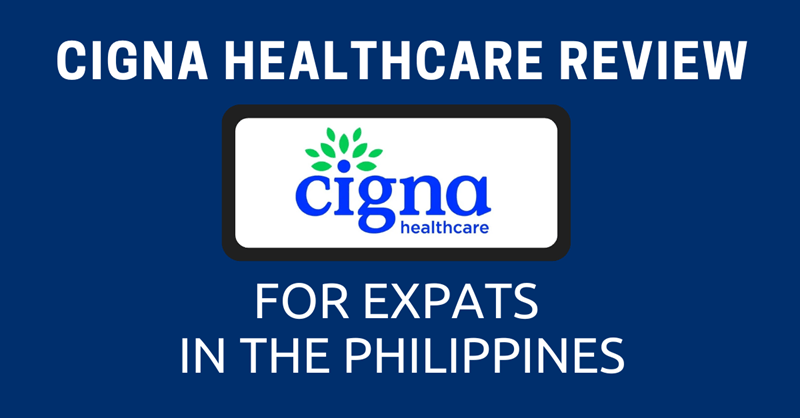
Wondering if Cigna Healthcare is right for expats in the Philippines? This in-depth review covers costs, plans, benefits, and whether it’s worth the price.
When I first looked at healthcare costs in the Philippines, I honestly thought health insurance wouldn’t be necessary. After all, medical care here is pretty affordable, especially compared to countries like the U.S. or Singapore. But I was wrong.
Having insurance isn’t just about covering big emergencies, it’s actually a good way to manage your hospital expenses and gives you the freedom to visit a private hospital without thinking twice. That peace of mind is a big deal.
Many expats I’ve spoken to feel the same. While there are a few local options, like HMOs, PhilHealth, and pre-paid plans. For most foreigners living in the Philippines, expat health insurance is still the most popular choice.
One of the names that comes up again and again in expat circles is Cigna Healthcare. In this review, I’ll go through everything you need to know about it, including costs, plans, coverage, and more. So you can decide if it’s the right fit for you.
This article will take approximately 22 minutes to read. Don't have the time right now? No worries. Email the ad-free version of the article to yourself and read it later!
Disclaimer: This article may include links to products or services offered by ExpatDen's partners, which give us commissions when you click on them. Although this may influence how they appear in the text, we only recommend solutions that we would use in your situation. Read more in our Advertising Disclosure.
Contents
- Key Takeaways
- What Is Cigna Healthcare?
- Why Should Expats in the Philippines Choose Cigna Healthcare?
- Downsides of Cigna Healthcare for Expats in the Philippines
- Plans and Coverage
- Area of Coverage
- Additional Coverage
- Cigna Healthcare Plan Comparison for Expats in the Philippines
- Which Cigna Healthcare Plan Should I Get?
- Exclusions and Pre-Existing Conditions
- How to Use Cigna Healthcare in the Philippines
- Should You Get Cigna Healthcare as an Expat in the Philippines?
- Cigna Healthcare vs. Local Insurance
- Cigna Healthcare vs Other International Insurance
- Is Cigna Healthcare a Good Plan for Retirees in the Philippines?
- How Much Does Cigna Healthcare Cost in the Philippines?
Key Takeaways
- Cigna Healthcare is popular among expats in the Philippines because of its comprehensive coverage, both within and outside of the Philippines.
- With Cigna Healthcare, you can access top private hospitals like St. Luke’s and Makati Medical Center without a second thought.
- Their Silver plan starts with a US$1 million annual limit, which is already more than enough for most treatments in the Philippines.
- Cigna Healthcare has partnered with leading private hospitals throughout the Philippines. You often won’t need to pay upfront.
- I personally like the support features like telehealth and case management provided by Cigna Healthcare. You can speak to a doctor through the app or get help coordinating treatment.
- However, Cigna Healthcare can be more expensive than local options like HMOs or PhilHealth, but it also gives you much more coverage.
- Downsides include the price and limited maternity coverage (only available from the Gold plan and up). Medical evacuation is also not included unless you add it.
What Is Cigna Healthcare?
Cigna Healthcare is a U.S.-based insurance company that’s been around for centuries and known for international health insurance. In the Philippines, it’s already one of the more recognized names in the expat community, right up there with other major players like AXA.

On the other hand, plans from big international insurance companies like Cigna Healthcare (and other major players in the market) do tend to be more expensive. But honestly, that’s to be expected.
Also, the higher price comes with good reason. It’s not just about broad international coverage or solid benefits. Cigna Healthcare also offers extra support services, like their case management program, which I personally really like. I’ll talk more about that later in the article.
Why Should Expats in the Philippines Choose Cigna Healthcare?
While Cigna Healthcare plans are generally more expensive than local health insurance options in the Philippines, there are many reasons why expats in the Philippines still choose Cigna Healthcare.
Higher Coverage Limits
Local insurance plans in the Philippines, such as HMOs and pre-paid health cards, often come with low annual limits, typically ranging from PHP 100,000 to PHP 500,000 (around US$1,700 to US$8,500).
In comparison, Cigna Healthcare Silver, which is their starting plan, already comes with a US$1 million annual limit.
Because of this high annual limit, Cigna Healthcare may be able to cover the full cost of treatment, even if it involves surgery and extended hospitalization.
International Coverage
Cigna Healthcare plans include international coverage. This means you can choose to receive treatment outside the Philippines, which can be more important than it seems at first. For example:
- If you need serious treatment, you can go to countries with better medical facilities, such as Thailand or Singapore.
If you decide to move out of the Philippines in the future, you can usually keep the same plan. - Cigna Healthcare also includes home country coverage, so you can fly home for treatment or receive care while visiting your home country.
This flexibility is something that most local health insurance plans don’t offer.
Hospital Network and Direct Billing
Since Cigna Healthcare offers high coverage, you can visit any leading hospital in the Philippines without having to worry about the bill. Even their starting plan comes with US$1,000,000 in coverage, which is more than sufficient for most treatments in the country.
In fact, Cigna Healthcare works with several major private hospitals in the Philippines, including:
When visiting these hospitals or other private hospitals in the Philippines, most of them can bill Cigna Healthcare directly, so you don’t need to pay upfront.
Good to know: One Cigna Healthcare from reddit shared that St. Luke’s BGC has a VIP lounge on the ground floor for Cigna Healthcare clients. If you’re insured, you can wait there. This reflects both the premium nature of the insurance and Cigna Healthcare’s relationship with top hospitals in the Philippines.
Telehealth and Case Management Services
This is a benefit I rarely see from other insurance providers.
If you’re insured with Cigna Healthcare and don’t want to go to a hospital, you can schedule a telehealth consultation with one of their doctors directly through the app.
In case you’re seriously ill, Cigna Healthcare also offers a case management service. They’ll assign a dedicated point of contact who will help coordinate everything, from recommending a doctor to scheduling your hospital visit.
It’s a very useful feature, especially because they can often recommend a specific doctor at a particular hospital. This makes the entire treatment process much smoother and less stressful.
Downsides of Cigna Healthcare for Expats in the Philippines
While Cigna Healthcare offers strong international coverage and support, it’s not without drawbacks. Here are three main limitations you should be aware of before you decide if it’s the right fit for you:
- Not the Cheapest Option: In my opinion, this is the biggest drawback. Cigna Healthcare is not the most affordable health insurance provider on the market. Its plans come with a higher price tag compared to many local options or budget international insurers.
- Maternity Care Only Included in Gold Plans and Above: Maternity coverage is not included in the starting plan.You’ll need to enroll in at least the Gold plan to access maternity and newborn benefits.
- Optional Medical Evacuation and Repatriation Coverage: Medical evacuation and repatriation are not included in Cigna Healthcare’s base plans. If you want this coverage, you’ll need to add it as an optional module. That said, all plans include local ambulance services, both road and air, as part of the core benefits.
Therefore, in my opinion, Cigna Healthcare stands out as a solid option if you need comprehensive insurance that allows you to visit any leading private hospital in the Philippines, along with reliable customer service and international coverage, provided you have some budget for your health insurance plan.
Plans and Coverage
There are three main plans coming with Cigna Healthcare: Silver, Gold, and Platinum. The higher plan comes with higher coverage and give you additional coverage as well.
The most important point is the Gold plan that gives you maternity coverage while it isn’t available from the Silver plan.
Silver Plan
While technically Cigna Healthcare’s introductory global plan, it’s often more than sufficient for expats in the Philippines. The plan includes US$1,000,000 in annual coverage, which is typically enough, even at top private hospitals, given that healthcare costs in the country are relatively affordable.
In fact, some of the most expensive treatments in the Philippines still fall well under that amount. For example, according to ASCO Publications, ICU rates can exceed PHP 50,000 per day (over US$900), and cancer treatment can cost anywhere from PHP 120,000 to over PHP 1,000,000 (US$2,000–US$17,000),
Key Benefits:
- US$1,000,000 annual limit
- Private hospital room
- Coverage inside and outside the Philippines (depending on your selected area)
- Full cancer care up to US$1,000,000
- Advanced imaging (MRI, CT, PET) up to US$10,000
- Rehabilitation and physiotherapy up to US$5,000
- Emergency room treatment up to US$500
- Transplant services included
For most expats, this is the plan I’d recommend, unless:
- You plan to get treatment in a country with significantly higher healthcare costs, such as Singapore or the United States
- You need maternity coverage, which is only available starting from the Gold plan.The Silver Plan only covers newborn care of up to US$25,000 for up to 90 days.
Gold Plan
The Gold plan increases the annual limit to US$2,000,000 and adds key benefits not included in the Silver plan, most notably, inpatient maternity and newborn care. If you’re planning to start a family while living abroad, this plan offers the essential coverage you’ll need.
Key Benefits:
- US$2,000,000 annual limit
- Inpatient maternity care and childbirth coverage
- Up to US$75,000 in newborn care
- Higher sub-limits for advanced imaging, rehabilitation, and other services
So, if maternity care is something you’ll need, this plan is worth the upgrade.
Case study: One expat shared on reddit that Cigna Healthcare fully covered their maternity suite at Makati Medical Center (MMC), which is one of the top private hospitals in the Philippines.
Platinum Plan
The Platinum plan offers unlimited annual coverage and includes the highest level of benefits across all categories. In addition to maternity and newborn care, it also provides comprehensive mental and behavioral health coverage, which is not fully included in the lower-tier plans.
Key Benefits:
- Unlimited annual coverage
- Extensive mental and behavioral health benefits
- Up to US$42,500 for maternity care
- Up to US$156,000 for newborn care
- Enhanced limits across all major treatment categories
That said, unless you have specific ongoing mental health needs, require unlimited coverage, or frequently travel to countries with expensive healthcare systems, this plan is probably more than you need. For most expats, the Silver or Gold plan is more than sufficient.
Area of Coverage
Cigna Healthcare gives you two main options when it comes to choosing your area of coverage:
- Worldwide excluding the USA
- Worldwide including the USA
If you choose to include the USA in your coverage, your premium will be significantly higher. This is standard across all international insurance providers due to the high cost of healthcare in the United States.
That said, there are two important things to keep in mind:
- Emergency Coverage in the USA
Even if you choose the “Worldwide excluding the USA” option, Cigna Healthcare still provides up to US$100,000 in emergency outpatient coverage while you’re visiting the U.S.. For example, if you’re injured in an accident during a short trip. - Countries Not Covered
Cigna Healthcare cannot provide coverage in certain countries such as Cuba, Iran, Syria, North Korea, Sudan, Libya, and the Democratic Republic of the Congo. But these are not common destinations for expats.
Additional Coverage
Cigna Healthcare offers several optional add-ons for its Silver, Gold, and Platinum plans. Coverage limits for each add-on depend on your core plan level. For instance, Gold and Platinum plans come with higher sub-limits than the Silver plan.
Outpatient Treatment
This add-on covers medical services that don’t require you to be admitted to a hospital. That includes doctor consultations, diagnostic tests, vaccinations, and prescribed medications. It also includes hearing aids and physical therapy.
Under the Silver plan, the limits include:
- Annual limit: US$15,000
- Specialist consultations: US$2,500
- Diagnostic imaging/X-rays: US$2,500
- Outpatient rehabilitation: US$5,000
Should you get it?
For most expats living in the Philippines, I don’t recommend it. Outpatient care, such as a doctor’s visit or lab work, is relatively inexpensive. For example, even an outpatient consultation at Makati Medical Center costs around PHP 1,600.00 on the high end, which is roughly US$27–$30. It’s often more affordable to just pay these bills out of pocket than to add outpatient coverage to your plan. It’s often more affordable to just pay these bills out of pocket.
Evacuation and Repatriation
This add-on gives you access to emergency medical evacuation to the nearest appropriate medical facility. It also covers repatriation to your home country if needed.
In case of political unrest or natural disasters, this plan includes access to the Crisis Assistance Plus Program, which can help arrange alternative travel, accommodations, or other support.
Should you get it?
Yes, I’d recommend this add-on for expats in the Philippines.
While big cities like Manila and Cebu have decent hospitals, infrastructure outside major areas is limited. Also, the country is vulnerable to natural disasters like typhoons and earthquakes.
To give you an idea, the Philippines experiences around 20 tropical cyclones annually, with approximately 7–9 making landfall. Also, according to the Earthquake List, the country has a lot of earthquake activity, with over 800 earthquakes of magnitude 4.0 or higher happen each year within 300 km, which means there’s at least one tremor every 10 hours.
Having evacuation and repatriation coverage can give you peace of mind, especially if you plan to travel between islands or live in more remote regions. Also, the Crisis Assistance Plus Program can be a big help during natural disasters, which, as mentioned earlier, can occur in the Philippines.
Health and Wellbeing
This add-on focuses on preventive healthcare and mental health support. It covers routine checkups, screenings, and counseling sessions.
Under the Silver plan, you’re covered for:
- Routine annual physicals (up to US$325)
- Cancer screenings (cervical, prostate, breast)
- Footcare (up to 5 sessions per year)
- Mental health support: 20 in-person sessions per year
- 24/7 access to mental health professionals via the Cigna Healthcare app
Should you get it?
I don’t think so. It’s usually more affordable to pay for health check-ups yourself. However, having routine checkups and mental health coverage already included might encourage you to actually use them, especially if you’re adjusting to life in a new country.
Vision and Dental
This add-on covers basic dental treatments and vision-related services such as eye exams and glasses.
For the Silver plan:
- Eye test: US$100
- Prescription lenses and glasses: US$155
- Dental care: US$1,250 total per year
Note: Dental coverage ranges from 40% to 80%, depending on the type of procedure (preventive, basic, or major). You’ll be responsible for paying the remaining portion.
Should you get it?
No, not at all. In fact, I don’t really see the benefits of this add-on. It might just be me, but in most cases, it’s more practical to pay for these treatments yourself, whether you’re in the Philippines or elsewhere.
Cigna Healthcare Plan Comparison for Expats in the Philippines
Here’s Cigna Healthcare health insurance comparison table for expats in the Philippines
| Feature / Plan | Silver | Gold | Platinum |
| Annual Limit | US$1,000,000 | US$2,000,000 | Unlimited |
| Geographic Coverage | Worldwide (area selectable) | Worldwide (area selectable) | Worldwide (area selectable) |
| Hospital Room Type | Private | Private | Private |
| Hospitalization (Inpatient) | Yes | Yes | Yes |
| Outpatient Care | Optional Add-on | Optional Add-on | Optional Add-on |
| Mental Health Coverage | Yes (Basic: up to US$5,000) | Yes (Enhanced: up to US$10,000) | Yes (Maximum: up to 90 days) |
| Maternity Coverage | No | Yes (with optional add-on) | Yes (with optional add-on) |
| Newborn Care | No | Yes (US$25,000 limit) | Yes (up to US$156,000) |
| Road and Air Ambulance | Yes | Yes | Yes |
| Telehealth Consultations | Yes | Yes | Yes |
| Best For | Everyone | Those who need maternity coverage. | Those who want to get a complete peace of mind |
Which Cigna Healthcare Plan Should I Get?
For most expats living in the Philippines, the Silver plan with the Evacuation and Repatriation add-on is more than enough. It already gives you US$1 million in annual coverage, which covers almost anything you might need at top hospitals like Makati Medical or St. Luke’s.
The Evacuation and Repatriation add-on is something I recommend, especially if you plan to live outside major cities or travel between islands. It gives you that extra safety net during natural disasters, which, as you know, happen quite often in the Philippines.
However, if you’re planning to start a family and want maternity coverage, you’ll need to go with the Gold plan. Maternity and newborn care aren’t included in the Silver plan, so upgrading to Gold is the only way to get those benefits.
Exclusions and Pre-Existing Conditions
Like most private health insurance providers, Cigna Healthcare has a list of standard exclusions, and it’s important to understand them before you buy a plan.
Common exclusions include:
- Pre-existing conditions
- Self-inflicted injuries
- Cosmetic procedures
- Fertility treatments
- Experimental or unproven therapies
This is pretty standard in the industry and not something unique to Cigna Healthcare.
That said, one thing I like about Cigna Healthcare is that they may be willing to cover or help manage certain common pre-existing conditions, such as:
- Hypertension
- Type 2 diabetes
- Asthma
Tip: Still, if you have any pre-existing condition, it’s essential to check with Cigna Healthcare directly before signing up. Ask them specifically what’s covered and what’s excluded. If possible, request a written confirmation. This helps avoid misunderstandings later, especially when you need to make a claim.
How to Use Cigna Healthcare in the Philippines
With Cigna Healthcare, you can visit any private hospital in the Philippines and simply show your Cigna Healthcare card. In most cases, the hospital will bill Cigna Healthcare directly. This is known as direct billing.
If you need to pay upfront and make a claim later (such as for outpatient treatment), you can upload the bills and medical receipts through the Cigna Healthcare app. Once the documents are submitted, reimbursements are typically processed within five working days.
If it’s a planned treatment, it’s a good idea to contact Cigna Healthcare in advance to get pre-authorization. This allows them to issue a guarantee of payment, helping you avoid any risk of denial by the hospital.
Tip: I always recommend contacting your insurance company first, whether it’s Cigna Healthcare or another provider. Pre-authorization doesn’t just secure payment; they might also help you choose the right hospital or doctor based on your condition.
From what I’ve seen so far, Cigna Healthcare generally handles claims efficiently. Of course, there are occasional claim denials, but these usually are from policy exclusions the customer wasn’t aware of. The best way to avoid this is to always request pre-authorization before receiving care.
The good news is, Cigna Healthcare offers 24/7 live support in multiple languages, including English, German, Spanish, and more, making it easy to reach them anytime you need assistance.
Should You Get Cigna Healthcare as an Expat in the Philippines?
That depends on your budget and healthcare needs. Cigna Healthcare is a good fit for you if:
- You want health insurance that actually pays when you need it
- You want to visit any leading private hospital in the Philippines without a second thought
- You need international coverage, whether you travel regularly, plan to leave the Philippines in the future, or prefer getting treatment in another country
- You value having real support, with someone who can help manage your care when you’re unwell
- You don’t mind paying a bit more for a comprehensive plan with strong benefits
On the other hand, Cigna Healthcare probably isn’t the right choice if your main priority is getting the cheapest insurance plan available. In my opinion, price is the biggest downside of Cigna Healthcare.
If you think Cigna Healthcare might be the right fit for you, you can get started by getting a free quote from their official website. There, you can explore plans and see what coverage looks like based on your location and health needs.
Cigna Healthcare vs. Local Insurance
Cigna Healthcare works very differently from local insurance providers in the Philippines.
Local insurance is much cheaper than Cigna Healthcare, or any international insurance, for that matter, but it also comes with lower coverage limits and internal sub-limits that can be difficult to understand. These sub-limits often apply to specific treatments or room types, and navigating them can be confusing, especially if you’re used to insurance plans from back home.
Local plans also mainly cover treatment within the Philippines, and may not be accepted at international hospitals if you travel abroad.
That said, local insurance can still be a good option if you’re on a tight budget and only need coverage within the Philippines. Just make sure to study the policy carefully and understand what is and isn’t covered since the structure is very different from international insurance plans like Cigna Healthcare.
Cigna Healthcare vs Other International Insurance
In my opinion, what I really like about Cigna Healthcare is the support, telemedicine, and case management service. These are features you rarely find with other insurance providers. You also get access to their app, which makes it easy to manage everything, from claims to contacting support, all in one place.
That said, if you’re on a budget and still want international insurance, you might want to check out ACS. They released a new plan in 2025 that’s more affordable. However, it also comes with some trade-offs—such as caps on certain benefits, like private room coverage.
So while it’s cheaper, it offers fewer features compared to Cigna Healthcare. You can read my ACS review here.
AXA is another major competitor of Cigna Healthcare in the Philippines. In my opinion, AXA also offers a solid plan. But personally, I still prefer Cigna Healthcare, mainly because of the level of support they provide. When you’re seriously ill, having someone guide you through your treatment and coordinate care is a major plus, and something that’s hard to find with most providers.
Is Cigna Healthcare a Good Plan for Retirees in the Philippines?
Admittedly, Cigna Healthcare can be expensive for retirees, but that’s true for most private health insurance providers. Once you’re over 60, it’s often difficult to find any international insurer willing to offer coverage at all, let alone with strong benefits.
That’s why, if you have the budget, Cigna Healthcare is actually a good option for retirees in the Philippines for several reasons:
- No age cap for joining
- No renewal age limit
- They can help manage certain pre-existing conditions, like hypertension
That said, you should expect to pay over US$4,000 per year. However, there are ways to reduce your premium. For example, you can increase your deductible and cost-sharing options to lower the annual cost, especially if you don’t expect to use the insurance frequently.
How Much Does Cigna Healthcare Cost in the Philippines?
Cigna Healthcare isn’t as expensive as you might think. In fact, I find the price quite reasonable. For a 40-year-old male, the Silver plan with a US$750 deductible costs around US$271.55 per month.
While it’s definitely pricier than local health insurance plans, considering the coverage you get, both within and outside the Philippines, it seems fair to me.
Please note that this is just an estimated price. It’s hard to give an exact quote since many factors come into play, including age, plan type, and optional benefits. If you want to check your own rate, you can do so using this link.
Disclaimer
This article is based solely on my personal in-depth research on Cigna Healthcare, including a thorough review of their brochures and policy documents. I’m also quite familiar with expat health insurance in general. Since running ExpatDen, I’ve had the opportunity to regularly speak with insurance brokers and company representatives, including those from Cigna Healthcare, directly.
That said, mistakes can still happen. Coverage details may also change over time or vary depending on your personal health profile. When in doubt, always refer to the official policy documents or speak with a licensed insurance agent or broker. And make sure to get important details in writing.





